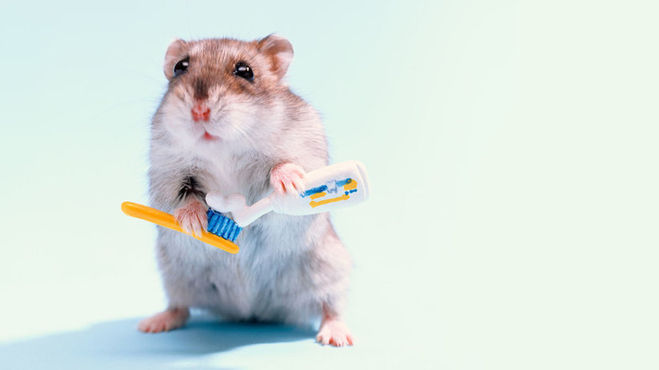A hamster’s teeth are an important criterion for assessing the health of a rodent because he is born to “gnaw”. The peculiarity of the front incisors is that they grow all their lives, so they constantly need to be sharpened. To monitor your pet’s health, it is important to know how many teeth a hamster has. If you’ve never looked into your pet’s mouth, you might think that it has only two front “fangs”, but this is not so. The hamster has 16 teeth: these are 2 incisors on top, 2 below, and 6 molars for chewing food. At first glance, only 4 incisors are visible. To see the other 12, you need to lightly take the hamster by the mane, pull back the cheek pouches.
Why Does the Hamster Have an “Amber” Smile?

These animals have yellow enamel, not white. If the incisors have turned very yellow in a short period of time or a brown coating has appeared, this may indicate old age or that there are a lot of dyes in the animal’s food. If you are worried about yellowness, let go of the bad thoughts, because a healthy hamster has that color of incisors. We figured out why the hamster has yellow teeth – for him, it is quite natural.
If you have a hamster, you probably made sure that you set a chalk or mineral stone in the cage so that it can sharpen the incisors that grow throughout its life. Stones or twigs should always be in the little pet’s cage.
To properly care for your animal, study the structure of your hamster’s teeth. They have no roots, so they grow without stopping. Due to the absence of nerve endings at the base, grinding is painless.
The expression “sharpens its teeth” should not be taken literally: the animal gnaws a hard object, as a result of which self-sharpening occurs. Nature has thought of everything: the rodent’s incisors are unevenly covered with enamel, on the front side – a strong layer, on the back – thin or absent. When the animal gnaws hard objects, the incisors do not wear off evenly but are sharpened like a chisel. The molars are also self-sharpening since they have surfaces and irregularities.
When is Dental Care Needed?
Do hamsters lose teeth? Unfortunately, this happens. This is preceded by trauma, as a result of which the tooth can fall out or break off. What to do if a hamster has a broken tooth? Don’t worry too much. If one of the incisors breaks, it should grow back. The owner’s task is to monitor the length and safety of the remaining teeth. After the injury, the animal will “take care” of the incisors and not use them to the fullest, which leads to their rapid growth and inadequate grinding. This situation is dangerous because the rodent will not be able to eat normally, you will have to cut the hamster’s teeth. A veterinarian can do this, the procedure is simple and the doctor will quickly remove the excess.
It is not worth shortening long incisors on your own, but if there is no way to consult a doctor, try yourself as a specialist. Use a kitty nail clipper or nail clipper to manipulate. It is important to cut off only the part that is unnecessary. After the length is normalized, your intervention is not required, the hamster will continue to sharpen them on its own.
Features of the Jaws of Hamsters of Different Breeds
Teeth are a sore subject not only for humans but also for some hamsters. Syrian and Dzungarian rodents are no exception. They often have incisor disorders, this is due to genetics, injuries. The animal can get injured due to the habit of gnawing everything, even what is not intended for this. One of these bad habits is the metal rods of the cage. If there are problems with the teeth, they need to be solved immediately, otherwise, the hamster will have a hungry diet – because of the pain, the baby will refuse to eat.
The most common problems for Dzungarian and Syrian hamsters:
- Incisors grow unevenly. Due to this problem, a number of other problems can develop, such as uneven grinding, ingrowth of incisors into the cheek pouches and palate. If the crumb has lost weight, and with light pressure on the cheeks, it feels discomfort – this is an alarming bell. This can be inherited.
- The upper and lower incisors are broken. It is necessary to ensure that the tooth opposite the injured person is not too long.
How Can Diseases be Prevented?
You already know what teeth hamsters have, but it is very important to learn how to properly monitor them. To detect problems in time, periodically examine the jaws. The crumbs really do not like such manipulations and will try to escape. If, after pushing back the cheek pouches, you see straight, straight teeth and their length is proportional to each other, this means that everything is fine. It is important that calcium is supplied to the hamster’s body in the right amount, check its content in purchased food.
Interesting facts and tips:
- The first symptom of jaw problems is increased salivation. This can happen if a tooth falls out;
- a hamster that grinds his teeth is most likely unhappy with something, has experienced a stressful situation, or something does not allow him to relax;
- fear can provoke a baby to inappropriate behavior. This answers the question of why the hamster is chattering his teeth. He can be annoyed by obsessive communication, strangers, and even smells;
- the reason for the poor health of the rodent may be that the jaws do not close, as a result of which the remains of food accumulate in the bags;
- curved incisors do not allow the animal to eat normally.
If you have the slightest suspicion that your hamster’s teeth are hurting, take it to your veterinarian.

